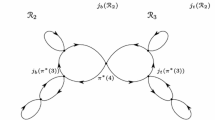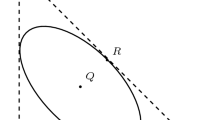Abstract
We classify the Rauzy–Veech groups of all connected components of all strata of the moduli space of translation surfaces in absolute homology, showing, in particular, that they are commensurable to arithmetic lattices of symplectic groups. As a corollary, we prove a conjecture of Zorich about the Zariski-density of such groups.
Similar content being viewed by others
Notes
This result uses the classification of finite simple groups.
References
Avila, A., Matheus, C., Yoccoz, J.-C.: Zorich conjecture for hyperelliptic Rauzy–Veech groups. Math. Ann. 370, 785–809 (2017)
Avila, A., Viana, M.: Simplicity of Lyapunov spectra: proof of the Zorich–Kontsevich conjecture. Acta Math. 198(1), 1–56 (2007)
Benoist, Y.: Propriétés asymptotiques des groupes linéaires. Geom. Funct. Anal. 7(1), 1–47 (1997)
Berrick, A.J., Gebhardt, V., Paris, L.: Finite index subgroups of mapping class groups. Proc. Lond. Math. Soc. 108(3), 575–599 (2014)
Filip, S.: Zero Lyapunov exponents and monodromy of the Kontsevich–Zorich cocycle. Duke Math. J. 166(4), 657–706 (2017)
Farb, B., Margalit, D.: A Primer on Mapping Class Groups. Princeton Mathematical Series, vol. 49. Princeton University Press, Princeton, NJ (2012)
Forni, G.: Deviation of ergodic averages for area-preserving flows on surfaces of higher genus. Ann. Math. 155(1), 1–103 (2002)
Grove, L.C.: Classical Groups and Geometric Algebra. Graduate Studies in Mathematics, vol. 39. American Mathematical Society, Providence, RI (2002)
Gutiérrez-Romo, R.: Simplicity of the Lyapunov spectra of certain quadratic differentials. (2017). arXiv: 1711.02006 [math.DS]
Johnson, D.: Spin structures and quadratic forms on surfaces. J. Lond. Math. Soc. 22(2), 365–373 (1980)
Kontsevich, M., Zorich, A.: Connected components of the moduli spaces of Abelian differentials with prescribed singularities. Invent. Math. 153(3), 631–678 (2003)
Magee, M.: On Selberg’s Eigenvalue Conjecture for moduli spaces of abelian differentials. Preprint (2016). arXiv: 1609.05500 [math.DS]
Mumford, D.: Tata lectures on theta. I. Modern Birkhäuser Classics. With the collaboration of C. Musili, M. Nori, E. Previato and M. Stillman, Reprint of the 1983 edition. Birkhäuser Boston Inc, Boston, MA (2007)
Rauzy, G.: Échanges d’intervalles et transformations induites. Acta Arith. 34(4), 315–328 (1979)
Veech, W.: Gauss measures for transformations on the space of interval exchange maps. Ann. Math. 115(1), 201–242 (1982)
Viana, M.: Ergodic theory of interval exchange maps. Rev. Mat. Complut. 19(1), 7–100 (2006)
Yoccoz, J.-C.: Interval exchange maps and translation surfaces. In: Homogeneous Flows, Moduli Spaces and Arithmetic, Vol. 10. Clay Mathematics Proceedings of American Mathmatical Society, Providence, RI, pp. 1–69 (2010)
Zorich, A.: Explicit Jenkins–Strebel representatives of all strata of Abelian and quadratic differentials. J. Mod. Dyn. 2(1), 139–185 (2008)
Zorich, A.: How do the leaves of a closed 1-form wind around a surface? In: Pseudoperiodic Topology, vol. 197. American Mathematical Society Translations Series 2. American Mathematical Society, Providence, RI, pp. 135–178 (1999)
Acknowledgements
I am grateful to Giovanni Forni for his interesting questions and remarks which motivated the newer versions of the article. I am also grateful to the two anonymous referees whose comments greatly improved the presentation of the results, and to my advisors, Anton Zorich and Carlos Matheus.
Author information
Authors and Affiliations
Corresponding author
Appendix
Appendix
In this section we will explicitly state some computations for the base cases of the induction used to prove Theorem 1.4. Specifically, these facts were used to show that some permutations belong to the desired minimal strata and that the modulo-two reduction of the Rauzy–Veech groups are the entirety of the orthogonal groups.
It is possible to find all elements of \({\mathrm {NS}}(\tau ^{(d)})\) for small values of d by hand. This was done to find the base cases of the induction in Lemma 4.1. In particular.
Fact 1
\({\mathrm {NS}}(\tau ^{(6)})\) consists of 36 elements, which, written on the basis \((\overline{e}_\alpha )_{\alpha = 1}^6\), are:
Fact 2
\({\mathrm {NS}}(\sigma ^{(8)})\) consists of 120 elements, which, written on the basis \((\overline{e}_\alpha )_{\alpha = 1}^8\), are:
Proving that \(\{\overline{e}_\alpha \}_{\alpha \in \mathscr {A}}^{Q^{(d)}} = {\mathrm {NS}}(\pi ^{(d)})\) for the base cases of the induction can be done as follows: we start with the set \(S_1 = \{\overline{e}_\alpha \}_{\alpha \in \mathscr {A}}\), which is contained in \(\{\overline{e}_\alpha \}_{\alpha \in \mathscr {A}}^{Q^{(d)}}\). We define the set \(S_{k+1}\) as the union of \(S_k\) with the set of vectors of the form \(v + \overline{e}_\alpha \), where \(v \in S_k\) and \(Q(v + \overline{e}_\alpha ) = 1\). Clearly, \(S_k \subseteq \{\overline{e}_\alpha \}_{\alpha \in \mathscr {A}}^{Q^{(d)}}\) for each k and, after a small number of iterations, it must be equal to \(\{\overline{e}_\alpha \}_{\alpha \in \mathscr {A}}^{Q^{(d)}}\). We can then check that \(\{\overline{e}_\alpha \}_{\alpha \in \mathscr {A}}^{Q^{(d)}} = {\mathrm {NS}}(\pi ^{(d)})\).
Rights and permissions
About this article
Cite this article
Gutiérrez-Romo, R. Classification of Rauzy–Veech groups: proof of the Zorich conjecture. Invent. math. 215, 741–778 (2019). https://doi.org/10.1007/s00222-018-0836-7
Received:
Accepted:
Published:
Issue Date:
DOI: https://doi.org/10.1007/s00222-018-0836-7




